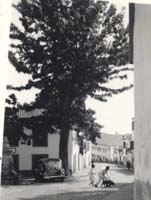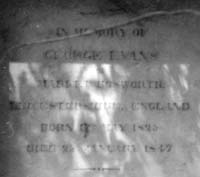English Cemetery, Funchal, Madeira. F.A.Roper visits
The Padre directed me to the English Cemetery, but was not able to conduct me
personally, as he had hurt his foot and was very lame. I found my way there from
the opposite direction to that I had taken the first day.
 The
photograph to the left shows the outside of the wall of the English
Cemetery on the right. This area was in the original cemetery which was
cut into when this road was made. The
photograph to the left shows the outside of the wall of the English
Cemetery on the right. This area was in the original cemetery which was
cut into when this road was made.
The small memorial to the left shows the original extent of the
cemetery.
The animal which the lads are playing with was a small black pig. |
The Cemetery is surrounded by a high wall, with solid iron and wood doors, which
are usually kept locked. They were open on this occasion, as Mrs Padre was there
with some other English visitors. When Miss Grey and I had gone before, we had
had to knock up the janitor, and entered through his own cottage garden.
The whole area of walls surrounding the oldest part of the cemetery was covered
almost edge to edge with memorial tablets which had been built in on their
removal from their original positions in the first cemetery. Many of the coffin
shaped grave stones were broken and nameless and the tablets in the walls were
overhung and shadowed by bushes and cascades of creepers. I spent a long, long
time going around the walls, picking my way behind bushes, and drawing aside the
curtains of climbing plants. I knew from the old sketch at home that there was a
mural tablet to my Grandfather and a Great uncle, so I knew what to look for.
 Suddenly,
from a dark corner, shadowed by trees, and almost hidden by shrubs, that
familiar name leapt out at me, the name that is now my eldest brother’s
and his eldest son’s. JOHN WADDINGTON HUBBARD. Suddenly,
from a dark corner, shadowed by trees, and almost hidden by shrubs, that
familiar name leapt out at me, the name that is now my eldest brother’s
and his eldest son’s. JOHN WADDINGTON HUBBARD.
This, outshining all relics of my far more noteworthy Phelps forbears,
was what I had come to Madeira to find.Alongside the tablet to my
Grandfather is a similar one to a young Great uncle, who, as a medical
student, also contracted lung trouble, and came out to Madeira to stay
with the Phelps family, and died there.
|

|
Tablet to my Grandfather In memory of John Waddington
Hubbard of 16 Kensington Square London
Born July 10th 1823
Died at Funchal June 15th 1871
|

|
Tablet to my Great uncle In memory of George Evans of
Market Bosworth Leicestershire, England
Born 17th May 1825
Died 25th January 1847
|
Little is known of my Grandfather in the family archives, the main thing being
that my beautiful and talented Grandmother was well-nigh ostracised by certain
of her relatives for choosing to marry a young doctor, who, though of good old
East Anglian descent, was not of the “country” class, as they were. It was an
ideally happy marriage, though all too short. In the early forties my
Grandfather developed a lung complaint, and was brought to stay with the Phelps
relations in Madeira, in the hopes that the climate would aid his recovery. It
did not, however, and he died at the age of 48, leaving my Grandmother with four
small children. Even my father, the eldest, had hardly any recollections of his
own father. The little that I have ever heard of my Grandfather’s short life,
has always appealed to me very deeply. In a crayon portrait of him by my
Grandmother, though admittedly not a flattering likeness, he is shown as being
fair, with thick curly red-gold hair, which I believe my Father inherited.
Coming fairly late in my father’s life, I never knew his curls except as silver.
It was exceedingly difficult to get photographs of the tablets, owing to the
deep shadow from overhanging trees, and to a shrub almost directly in front.
Besides which a mass of other shrubs and undergrowth made it almost impossible
to stand in any suitable position for focussing.
There must be other family graves here, but I had no time to look for them. The
most recent seems to be in 1904, [Philip Arthur Frank Phelps, Died 12th July]
and this is the only one in the church registers. The details of this were given
to me in a note by Mr Cole, the churchwarden.
Back
 The
photograph to the left shows the outside of the wall of the English
Cemetery on the right. This area was in the original cemetery which was
cut into when this road was made.
The
photograph to the left shows the outside of the wall of the English
Cemetery on the right. This area was in the original cemetery which was
cut into when this road was made. 

